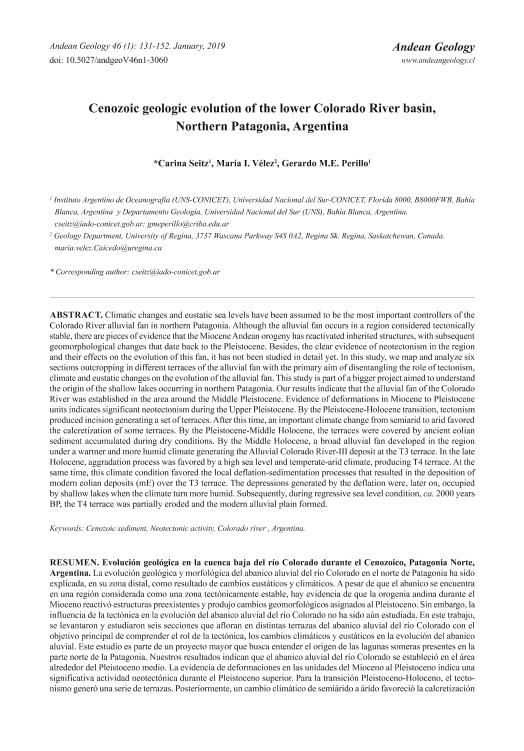Mostrar el registro sencillo del ítem
dc.contributor.author
Seitz, Carina

dc.contributor.author
Vélez, María I.
dc.contributor.author
Perillo, Gerardo Miguel E.

dc.date.available
2020-03-02T14:28:40Z
dc.date.issued
2019-01
dc.identifier.citation
Seitz, Carina; Vélez, María I.; Perillo, Gerardo Miguel E.; Cenozoic geologic evolution of the lower Colorado river Basin, Northern Patagonia, Argentina; Servicio Nacional de Geología y Minería; Andean Geology; 46; 1; 1-2019; 131-152
dc.identifier.issn
0718-7106
dc.identifier.uri
http://hdl.handle.net/11336/98606
dc.description.abstract
Climatic changes and eustatic sea levels have been assumed to be the most important controllers of the Colorado River alluvial fan in northern Patagonia. Although the alluvial fan occurs in a region considered tectonically stable, there are pieces of evidence that the Miocene Andean orogeny has reactivated inherited structures, with subsequent geomorphological changes that date back to the Pleistocene. Besides, the clear evidence of neotectonism in the region and their effects on the evolution of this fan, it has not been studied in detail yet. In this study, we map and analyze six sections outcropping in different terraces of the alluvial fan with the primary aim of disentangling the role of tectonism, climate and eustatic changes on the evolution of the alluvial fan. This study is part of a bigger project aimed to understand the origin of the shallow lakes occurring in northern Patagonia. Our results indicate that the alluvial fan of the Colorado River was established in the area around the Middle Pleistocene. Evidence of deformations in Miocene to Pleistocene units indicates significant neotectonism during the Upper Pleistocene. By the Pleistocene-Holocene transition, tectonism produced incision generating a set of terraces. After this time, an important climate change from semiarid to arid favored the calcretization of some terraces. By the Pleistocene-Middle Holocene, the terraces were covered by ancient eolian sediment accumulated during dry conditions. By the Middle Holocene, a broad alluvial fan developed in the region under a warmer and more humid climate generating the Alluvial Colorado River-III deposit at the T3 terrace. In the late Holocene, aggradation process was favored by a high sea level and temperate-arid climate, producing T4 terrace. At the same time, this climate condition favored the local deflation-sedimentation processes that resulted in the deposition of modern eolian deposits (mE) over the T3 terrace. The depressions generated by the deflation were, later on, occupied by shallow lakes when the climate turn more humid. Subsequently, during regressive sea level condition, ca. 2000 years BP, the T4 terrace was partially eroded and the modern alluvial plain formed.
dc.description.abstract
La evolución geológica y morfológica del abanico aluvial del río Colorado en el norte de Patagonia ha sido explicada, en su zona distal, como resultado de cambios eustáticos y climáticos. A pesar de que el abanico se encuentra en una región considerada como una zona tectónicamente estable, hay evidencia de que la orogenia andina durante el Mioceno reactivó estructuras preexistentes y produjo cambios geomorfológicos asignados al Pleistoceno. Sin embargo, la influencia de la tectónica en la evolución del abanico aluvial del río Colorado no ha sido aún estudiada. En este trabajo, se levantaron y estudiaron seis secciones que afloran en distintas terrazas del abanico aluvial del río Colorado con el objetivo principal de comprender el rol de la tectónica, los cambios climáticos y eustáticos en la evolución del abanico aluvial. Este estudio es parte de un proyecto mayor que busca entender el origen de las lagunas someras presentes en la parte norte de la Patagonia. Nuestros resultados indican que el abanico aluvial del río Colorado se estableció en el área alrededor del Pleistoceno medio. La evidencia de deformaciones en las unidades del Mioceno al Pleistoceno indica una significativa actividad neotectónica durante el Pleistoceno superior. Para la transición Pleistoceno-Holoceno, el tectonismo generó una serie de terrazas. Posteriormente, un cambio climático de semiárido a árido favoreció la calcretización de las terrazas. Durante el Pleistoceno-Holoceno medio, las terrazas fueron cubiertas por la acumulación de sedimentos eólicos antiguos en condiciones de clima seco. En el Pleistoceno medio se desarrolló un amplio abanico aluvial en la región, en un clima más cálido y húmedo, que generó los depósitos aluviales del río Colorado-III en un nuevo nivel de terraza (T3). En el Holoceno tardío, el proceso de agradación fue favorecido por un alto nivel del mar y un clima templado-árido, que produjo la terraza T4. Al mismo tiempo, estas condiciones climáticas favorecieron los procesos de deflación-sedimentación local que dieron lugar a la deposición de depósitos eólicos modernos (mE) sobre la terraza T3. Las depresiones generadas por la deflación fueron, más tarde, ocupadas por los lagos poco profundos cuando el clima se volvió más húmedo. Posteriormente, durante condiciones regresivas del nivel del mar, ca. 2000 años AP, la terraza T4 fue parcialmente erosionada y se formó la llanura aluvial moderna.
dc.format
application/pdf
dc.language.iso
spa
dc.publisher
Servicio Nacional de Geología y Minería

dc.rights
info:eu-repo/semantics/openAccess
dc.rights.uri
https://creativecommons.org/licenses/by/2.5/ar/
dc.subject
ARGENTINA
dc.subject
CENOZOIC SEDIMENT
dc.subject
COLORADO RIVER
dc.subject
NEOTECTONIC ACTIVITY
dc.subject.classification
Geología

dc.subject.classification
Ciencias de la Tierra y relacionadas con el Medio Ambiente

dc.subject.classification
CIENCIAS NATURALES Y EXACTAS

dc.title
Cenozoic geologic evolution of the lower Colorado river Basin, Northern Patagonia, Argentina
dc.title
Evolución geológica en la cuenca baja del río Colorado durante el cenozoico, Patagonia Norte, Argentina
dc.type
info:eu-repo/semantics/article
dc.type
info:ar-repo/semantics/artículo
dc.type
info:eu-repo/semantics/publishedVersion
dc.date.updated
2020-01-13T14:41:09Z
dc.journal.volume
46
dc.journal.number
1
dc.journal.pagination
131-152
dc.journal.pais
Chile

dc.journal.ciudad
Santiago de Chile
dc.description.fil
Fil: Seitz, Carina. Universidad Nacional del Sur. Departamento de Geología; Argentina. Consejo Nacional de Investigaciones Científicas y Técnicas. Centro Científico Tecnológico Conicet - Bahía Blanca. Instituto Argentino de Oceanografía. Universidad Nacional del Sur. Instituto Argentino de Oceanografía; Argentina
dc.description.fil
Fil: Vélez, María I.. University Of Regina; Canadá
dc.description.fil
Fil: Perillo, Gerardo Miguel E.. Consejo Nacional de Investigaciones Científicas y Técnicas. Centro Científico Tecnológico Conicet - Bahía Blanca. Instituto Argentino de Oceanografía. Universidad Nacional del Sur. Instituto Argentino de Oceanografía; Argentina. Universidad Nacional del Sur. Departamento de Geología; Argentina
dc.journal.title
Andean Geology

dc.relation.alternativeid
info:eu-repo/semantics/altIdentifier/url/http://www.andeangeology.cl/index.php/revista1/article/view/V46n1-3060/pdf
dc.relation.alternativeid
info:eu-repo/semantics/altIdentifier/doi/http://dx.doi.org/10.5027/andgeoV46n1-3060
Archivos asociados
